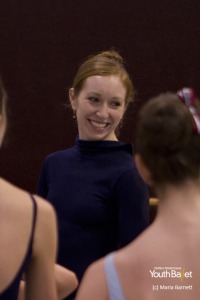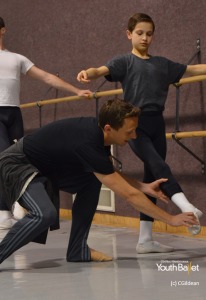We are sharing this article from David Dunkle, a guest blogger at Central Pennsylvania Youth Ballet. With a lifelong interest in telling people why they should love the arts, David recently spoke with choreographers Jeffrey Cirio, Kelly Ann Sloan and Matthew Powell about their new works premiering during June Series and with Darla Hoover about two Balanchine Company premieres.
Perhaps the hardest part of ballet is making it look easy.
The gifted students at Central Pennsylvania Youth Ballet are trained to make every movement on stage appear spontaneous, as if they just that moment thought of it. But the young dancers taking the stage during CPYB’s four-day June Series at Whitaker Center for Science and the Arts know that is far from the truth.
“It takes a lot of tries to get it right,” CPYB student Simon Hoke, 16, says. “We rehearse every day, for hours at a time. Once you get the basic movements down, there is still a lot of fine tuning.”
The truth is, little is left to chance during a ballet performance, whether it’s at a renowned regional school like Carlisle-based CPYB or one of the professional companies found in major cities.
In ballet, no croise devant or arabesque occurs randomly. Each movement is carefully planned and rehearsed for weeks or even months before the work is performed in front of an audience.
The task of arranging the flowing movements you see on stage falls to the choreographer, whose work allows dancers to bring music to three-dimensional life.
“The June Series is ballet stripped down to its purest form,” choreographer Matthew Powell, who has contributed an unusual all-male piece to the show, said. “There’s no scenery, no special effects. All you have is dancers on the stage.”
During the course of five different shows over a four-day period, CPYB’s dancers will bring back old classics from the school’s repertory and perform some works by the great choreographer George Balanchine for the first time. They also will unveil some entirely new works from promising contemporary choreographers Jeffrey Cirio, Kelly Ann Sloan and Powell.
Joining the school for two of the shows will be another group of talented youngsters, the musicians of the Harrisburg Symphony Youth Orchestra, conducted by Gregory Woodbridge. They will perform live at Whitaker during two performance of Cirio’s world premiere work, which is set on the lovely Violin Concerto in A minor conceived in the 18th century by the great composer Johann Sebastian Bach.
“It’s nice to perform with live music,” Cirio, a onetime CPYB student, said. “It varies a little every night, because it is not a recording. The live orchestra gives it more … magnitude. It’s deeper, richer.”

What the June Series does not feature are storybook ballets like Balanchine’s “The Nutcracker” or “The Sleeping Beauty,” which the school does perform at other times.
“Works like we present in June Series are an entirely different ballet experience for dancers and audiences alike,” CPYB Founding Artistic Director Marcia Dale Weary said.
Some choreographers start with the music, and others with the movements, but all are striving for a collaboration between dancers and music that creates art, whether it’s in a ballet hall or a Broadway stage.
Cirio said he often sees abstract movements in his head and then looks for the correct music to bring them to life. “I like to paint the music,” he said.
Sloan, a June Series veteran who contributed a work in 2012, said she is usually captivated by a particular composition, then begins imagining ways to transform it into ballet.
“Nine times out of ten I start with the music,” the former dancer with the Los Angeles Dance Company said. “I listen to the music over and over. Coming up with the actual steps is the last part of the process. I start by breaking down how I want it to look, kind of mapping it out loosely.”
She tries not to get locked into a choreographic plan too early, allowing the work to blossom once dancers become involved. “What ends up on stage,” she said, “is often completely different than what I first envisioned.”
This year, Sloan is using music from Anatoly Lyadov, Eduard Strauss and Henri Vieuxtemps to set a comic scenario for 14 of CPYB’s younger dancers, most ages 10 to 13. It’s about a fictional June Series ballet where things begin to go wrong.
The sequence can be seen during Wednesday’s opening concert, “Next Generation Dance.”

Sloan based her idea on an old superstition that it’s bad luck to wear a peacock feather on stage, a mistake that one of the dancers in her piece makes.
“She uses it as a hair adornment,” Sloan said. “Chaos ensues.”
It’s not easy for these dancers, who are trained toward perfection, to suddenly appear clumsy on stage. But Sloan said the nine girls and five boys who will perform in her piece are very focused and passionate about getting things right, even when that means making them look wrong.
“They are really good at it,” Sloan insisted. “They are able to make it look intentional. The students here are quick studies and very versatile.”
School founder Marcia Dale Weary says the June Series is an important part of the training that every CPYB student receives, whether they plan to have a professional career or not.
“We try to give every child – even the little ones – an opportunity to dance in June Series,” Weary said. “A young child who is given the chance to perform on stage becomes a natural at it. It’s like home. And they just love putting on their costumes – they look forward to it!”
In well-established works like those by the late Balanchine, steps and movements for each piece are prescribed with exactitude — especially in the heads of répétiteurs who have been trained to teach others how to perform them.
CPYB, one of the few schools in the nation authorized to perform Balanchine’s works, has a quite a few of his choreographies in its repertory, especially the popular ‘The Nutcracker’ ballet that students perform at Whitaker Center and Hershey Theatre each holiday season. In all cases, the responsibility for ensuring that the works are performed correctly falls to Balanchine répétiteur Darla Hoover, a CPYB alumna and longtime faculty member who once danced for Balanchine in his New York City Ballet.
At CPYB, students are steeped in the Balanchine method from early in their training, both through live performances and classroom work with Hoover.
“The kids are learning everything that Balanchine taught us,” Hoover said. “They have a reference point for everything I bring out. They know how I want to color the ballet.”
During this year’s June Series, CPYB dancers will perform two works from the Balanchine repertory — “Raymonda Variations” and “Valse-Fantaisie” — but also two pieces the school has never previously done: “Allegro Brillante” and “Emeralds.”
Balanchine created “Allegro Brillante” in 1956, calling it “everything I know about ballet in 13 minutes.” Set to Tchaikovsky’s Piano Concerto No. 3, it is a joyous, bravura work that even the most advanced dancers love to perform.
CPYB’s most advanced students will perform the work, including Abby Jayne DeAngelo, also known as “Peanut,” who has been training to be a ballerina since she was 7 and seems destined for professional success.
“Peanut can read my mind,” Hoover said of DeAngelo. “She was crazy good from a very young age.”
“Emeralds” is one third of “Jewels,” a three-act ballet that Balanchine created in 1967. Although costuming is not a big part of the June Series, it will play a prominent role in “Emeralds.”
“I remember being fresh at the New York City Ballet and seeing ‘Jewels,’” Hoover said. “I couldn’t wait to get into that costume. I can still remember the first time I tried on my ‘Emeralds’ costume. It was just exquisite, with long romantic, flowing tulles and tops that were jeweled with emerald stones.”
When it comes to Balanchine, Hoover is not a choreographer, but rather part of a living memory that preserves the nearly 400 works that the Russian-born artist created prior to his death in 1983.
“A big part of my job is rehearsing it as if Balanchine were rehearsing it,” Hoover said. “That’s where my experience having danced for him is very valuable.”
The June Series, more than any other public performance by CPYB, shines a light on the craft of choreography. The four days of concerts can serve as an excellent introduction to ballet, but also offer a chance for even ballet veterans to see something different.
For example, Matthew Powell, the newest member of CPYB’s permanent guest faculty, has put together a piece that features 12 young men — and no women.
“The ladies often dance in a corps de ballet,” Powell, a former professional dancer with San Francisco Opera, Pacific Northwest Ballet, and Kansas City Ballet, said. “They get a lot of practice dancing that way. The gentlemen don’t.”
Using music by Russian composer Sergei Rachmaninov, Powell has created a fast-moving work that will emphasize the inherent strength of the participants.
“It’s very precise,” he said. “They have to feel the space. I wanted to incorporate elements of traditional Russian character dances, while giving them a neoclassical twist. The steps are very grounded, very masculine.”
Many ballet schools would not be able to stage this work for the simple reason that they do not have a dozen male dancers under their roof. “I can’t think of too many schools that have enough men to execute the piece,” Powell said.

But CPYB does have sufficient resources.
“I’m like a kid in a candy store,” Powell said. “This is a first for me, too. I’m really ecstatic about the piece.”
That process of discovery is what motivates choreographers as well as the dancers who stage their works. Powell, Sloan and Cirio all agreed that they have enjoyed their partnership with CPYB’s young dancers.
“Students have to be really attentive and focused,” Sloan said, “but that’s never a problem here.”
Powell, who joined CPYB’s faculty in January, said the talent level at the school is amazing.
“They are kids, so they sometimes get tired and their minds wander,” he said. “But we were able to create this piece very quickly, with just four rehearsal days, because they are so committed to the work.”
Cirio, who has been choreographing for four years and recently created a well-received piece for his own Boston Ballet, is not only creating a world premiere for June Series, he’s integrating a live orchestra on a tricky Bach composition.
He doesn’t have much time for hand-holding — and not much need for it, either.
“They are so musical, they do things right, right away,” he said of CPYB’s dancers. “I’m happy that I started here. I wouldn’t be where I am without Marcia and CPYB. It’s one of the best ballet schools in America, in my opinion.”
Hoover said the Balanchine Trust would not allow CPYB students to perform Balanchine’s work if they were not exceptional.
“That’s Marcia’s doing,” she said. “Within her training they have so much stage experience at such a high level at such a young age. She makes them hear music in their hearts, and her passion is contagious. These kids are masterfully trained.”
As they will demonstrate during June Series.
Freelance writer David N. Dunkle misspent a good portion of his youth at a summer stock theater, sparking a lifelong interest in telling people why they should love the arts, including ballet. David’s current work can be seen regularly in both the Harrisburg Patriot-News and the Carlisle Sentinel. He lives in Harrisburg’s lovely Bellevue Park.






